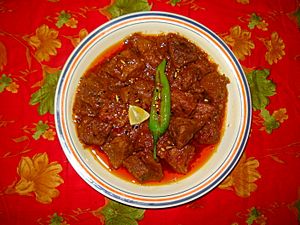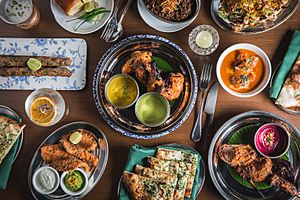Punjabi cuisine facts for kids
Punjabi cuisine is a special way of cooking food that comes from the Punjab region. This area is in the northern part of the Indian subcontinent, which is now split into an Indian part in the east and a Pakistani part in the west. Punjabi food has a long history with many unique cooking styles. One very famous style is tandoori cooking, which uses a special clay oven called a tandoor. This cooking style is now popular all over the world, including in India, Pakistan, England, Canada, and America.
The food in Punjab is greatly influenced by farming and agriculture, which has been important there since ancient times, like the Indus Valley civilization. The main foods grown locally are a big part of the cuisine. Punjabi food is known for its rich, buttery flavors and has many delicious vegetarian and meat dishes. Some popular dishes include sarhon dā saâg (a stew made from mustard greens) and makki di roti (flatbreads made from cornmeal).
Karrhi is a yellow, spicy gravy made with chickpea flour cakes. It often has lemon juice, red pepper, and turmeric. People usually eat it with rice or naan bread. Basmati rice, a special type of rice, comes from Punjab. Many rice dishes with meat and vegetables are made using it.
Contents
Cooking Styles in Punjab
There are many ways to cook in Punjab. In villages, people still use old-fashioned cooking methods and tools. This includes ovens heated by wood and ovens made of bricks. In cities, people often use gas cookers.
Tandoori Cooking
The tandoor is a traditional clay oven. Tandoori cooking is strongly linked to Punjab because Punjabis were among the first to widely use the tandoor in their region. After India was divided in 1947, many Punjabis moved to places like Delhi, and tandoori cooking became popular across India. In rural Punjab, it's common to find shared tandoors, sometimes called Kath tandoors.
Main Foods in Punjab
Punjab grows a lot of wheat, rice, and makes many dairy products. These foods are the main part of what Punjabi people eat every day. Punjab uses more dairy products per person than almost any other state in India. This shows how important dairy is in their diet.
Dairy Products
Dairy foods are a key part of Punjabi cooking. Both cow milk and water buffalo milk are popular. Milk is used for drinking, in tea or coffee, and to make homemade dahi (yogurt). It's also used for butter and a traditional Punjabi cheese called paneer. Yogurt is often made fresh daily using a little bit of the previous day's yogurt to help the milk ferment. Yogurt is used in many raita dishes, to make Kadhi, and to create buttermilk (Chaas). It can also be a side dish with meals. Buttermilk is used to make different kinds of Lassi drinks and sometimes in curries. Milk is also needed to make butter and Ghee (clarified butter).
Popular Punjabi Dishes
Breakfast Foods
Breakfast meals in Punjab can be different depending on the area. Some common breakfast foods include chana masala, nan, chole kulche, aloo paratha, panner paratha, gobi paratha, and paratha with curd or butter. Other popular choices are halwa poori, bhatoora, falooda, makhni doodh, Amritsari lassi, masala chai, and Amritsari kulchas.
Meat Dishes
Poultry, lamb, and goat meat are the most common types of meat eaten in different parts of Punjab.
Here are some well-known meat dishes:
- Biryani: A rice dish with lamb or chicken.
- Kebab: Cooked chicken or lamb meat, often served with naan or flatbread.
- Keema: Cooked minced lamb meat, usually eaten with naan.
- Lamb dishes: These include rogan josh, Bhuna Gosht, Kadhai Gosht, Raan Gosht, Dal Gosht, Saag Gosht, Nihari, Rara Gosht, and Paye da Shorba.
- Other chicken dishes: Shami kebab, chicken karahi, Amritsari tandoori chicken, Punjabi Karhi (a chicken yogurt curry), Butter Chicken (Murgh Makhni), and chicken tikka.
- Kunna Gosht: Meat cooked slowly in a clay pot.
- Haleem: A dish made from meat (beef or chicken) cooked slowly with different beans and spices. It's rich in protein and often served with lemon and fried onions.
Fish Dishes
Since Punjab is not near the ocean, freshwater fish is an important part of the food. Carp, rohu, and catfish are the most common types of fish prepared. Other fish include thela machi and tilapia. Recently, shrimp has also become available. Fish tikka is a special dish from Amritsar.
Vegetarian Dishes
- Khichdi: A dish made of grains and lentils. In Punjab, it's often made with millet flour, mung beans, and moth lentils. Rice with red lentils or mung beans is also eaten.
- Rajma: This is the Hindi word for red kidney beans. The beans are cooked in a medium-spicy onion-tomato gravy and usually served with steamed rice or Indian flatbread called Chapati.
- Paneer (freshly made cottage cheese) dishes: Such as Shahi Paneer; Khoya Paneer, Paneer Kofta (fried paneer pieces in a spicy gravy), Amritsari Paneer, Matar Paneer (paneer with green peas), paneer paratha (wheat flatbread stuffed with paneer), and Palak Paneer.
- Panjiri: A traditional North Indian dessert popular in Punjab. It has lots of almonds, walnuts, pistachios, dry dates, cashew nuts, whole wheat flour, sugar, and spices.
- Legumes: Many different types of beans and lentils are used, including chickpeas, pigeon peas, red lentils, mung bean, red kidney beans, and black gram. They can be used alone or mixed, like in Dal Makhani.
- Saag: A dish made from different leafy greens (like spinach and mustard greens). It's cooked into a stew with ginger, tomato, onion, garlic, chilies, and other spices. Sometimes, paneer or cream is added. Bathua is also used to make it taste better. It's served with butter on top and with makki ki roti. Saag is a popular winter and spring dish in Punjab.
- Eggplant: Baingan bharta is similar to baba ghanoush. The eggplant is roasted and peeled, but baingan bharta is richer, with lots of cooked tomato, browned onion, and various spices.
- Punj Ratani Dal: A thick gravy made with five different legumes, tomato, browned onion, and spices.
- Punjabi Kadhi Pakora: A traditional curry served with rice. Kadhi is a curry made with yogurt or buttermilk, thickened with chickpea flour, and seasoned with ginger, turmeric, chilies, and other spices. Deep-fried balls of spiced chickpea-flour batter (pakoras) are also added.
Snacks
- Toasted grains: In Punjab, it's a traditional treat to toast corn and wheat grains in a Punjabi bhathi (a special oven).
- Samosas: Popular fried pastries with savory fillings.
Raita and Chutney
Raita (yogurt-based side dish) or chutney (a flavorful condiment) are often served with main dishes.
Sweet Treats and Desserts
Punjabi cuisine has many different desserts and Mithyai (sweets), such as:
- Amritsari
- Kheer: A dessert made from rice, milk, and dry fruits.
- Khoya: A dairy product used in many sweets.
- Kulfi: An ice-cream-like dessert.
- Malpua: Sweet pancakes.
- Rabri: A sweet, thick milk dish.
- Semolina-based desserts: Like Halva.
- Sheer korma: A vermicelli pudding.
- Kaju katli: A sweet made from cashews.
- Atte ka halwa: A sweet made from wheat flour.
- Pinni: Made with clarified butter (desi ghee), wheat flour, almonds, and jaggery.
- Gulab jamun: Sweet, deep-fried milk solids balls.
- Jalebi: Sweet, crispy, spiral-shaped fried dough.
- Burfi: A milk-based sweet.
Breads in Punjabi Cuisine
Punjabis eat many kinds of breads. Both flatbreads and raised breads are eaten daily. Raised breads are called khamiri roti. Sometimes, sunflower and flax seeds are added to breads. Breads can be made from different types of flour and cooked in various ways:
- Baked in a tandoor: Like naan, tandoori roti, kulcha, or lachha paratha.
- Dry baked on an Indian griddle: Such as jowar ki roti, baajre ki roti, and makki ki roti (often served with white butter).
- Shallow fried: Like paratha.
- Deep fried: Like puri, Kachori, and bhatoora (made from fermented dough).
- Salt-rising bread: A special bread found only in the Salt Range region of Punjab, Pakistan. People used salt instead of yeast to make it rise.
- Papar: Thin, crispy flatbreads.
- Taftan: An Iranian bread popular in Pakistan and Lahore, often eaten with korma and nihari.
Herbs and Spices
Spices from the Indian subcontinent are very important in Punjabi cooking. They are often ground using a mortar and pestle or a food processor.
Drinks
Punjab has a wide variety of drinks. Some are made with dairy, like lassi and buttermilk. Drinks made with water buffalo milk are very common. Examples include mango lassi, mango milkshake, and chaas. Other drinks are made from fruits and vegetables, such as watermelon shakes, carrot juice, and tamarind juice (imli ka paani). Shikanjvi and neembu paani (lemonade) are especially popular in summer. Jal-jeera is also a common refreshing drink.
Sattu is a traditional North Indian drink also enjoyed in Punjab. It's made by roasting barley grains, grinding them into powder, and mixing with salt, turmeric, and water.
Fermented Foods
Fermented foods are common in Punjabi cuisine. They are also used in preparing some dishes. Mango pickle is particularly famous in many villages of Punjab.
Dining Customs in Punjab
How people eat is a big part of Punjabi culture. Every Punjabi home follows certain regional customs. While some customs vary, many are common throughout Punjab. Eating together as a family is a normal practice.
It's common to give fresh fruits, sweets, and food items as gifts to family members, especially in the spring season. Food is also shared with neighbors on special occasions as a sign of hospitality. Mangoes are considered a delicacy and are widely grown in Punjab. Mango parties are popular during harvest season. Watermelon and radish from food stalls are often shared among friends and relatives.
Important Dining Customs
Inviting Guests to Eat
- Invitations for a meal or tea are usually given a few days in advance.
- It's considered impolite to refuse an invitation without a good reason.
Table Manners
- Guests or older people are given special respect and attention.
- The invited guest is usually asked to start eating first. It's considered rude if the host starts eating before all guests are ready.
- The table is set before guests arrive.
- Family members usually try to eat dinner together.
- If someone else is nearby, they are offered food as a sign of respect. It's considered rude to start eating without asking others to join.
- Chewing food with an open mouth or burping loudly in front of others is considered rude.
- In Punjabi villages, a common plate is often placed on the table for bones from meat dishes. It's considered bad manners to put leftovers on the floor or table.
Using Eating Tools
- Punjabi families often use a mix of South Asian and European eating tools. Bread is eaten with hands. Rice and desserts are eaten with spoons. Soup spoons are used for soup, and forks are used for noodles.
Punjabi Dhaba
Along the roadsides, you can often find eateries called Dhabas. These places are also common spots to sit and chat. Some are like simple, casual restaurants.
Punjabi Restaurants Around the World
Punjabi food has become popular all over the world. For example, the Punjab restaurant in London has been run by the same family since 1946 and is the UK's oldest North Indian restaurant. The New Punjab Club in Hong Kong was the first Punjabi restaurant in the world to earn a Michelin Star in 2019, which is a very high award for restaurants.
See also
 In Spanish: Gastronomía de Punyab para niños
In Spanish: Gastronomía de Punyab para niños



